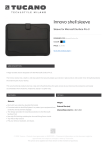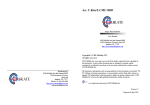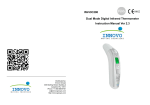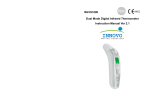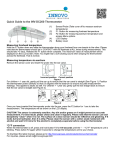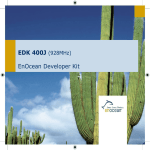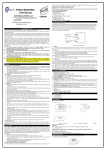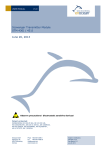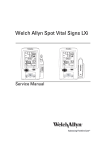Download Distributed by: Innovo Groups 406 Sterling Street, Building
Transcript
INV-430J Finger Pulse Oximeter User Manual Distributed by: Innovo Groups 406 Sterling Street, Building 2 Camphill, PA, 17011 Phone: +1-858-888-9781 [email protected] Innovo Groups 406 Sterling Street, Building 2 Camphill, PA, 17011 5.4 Copyright © Innovo Groups 2014. All rights reserved. Innovo Groups owns and reserves all of the rights comprised in the copyright of this document. No part of this document may be changed, excerpted, copied, reproduced, or imitated in any form or by any means without prior written consent of Innovo Groups. All statements, information, and recommendations in this document are provided "AS IS" without warranties, guarantees or representations of any kind, either express or implied. The information in this document is subject to change without notice. Innovo Groups reserves the right of final interpretation of this document. Version 1.1 Released on October 2014 Storage and Transportation mainframe-probe system of the Oximeter attributable to the mainframe of the Oximeter, the functional tester can test the accuracy of a pulse Oximeter that duplicates the calibration curve. Note: The product does not provide the alarm function and is not suitable for continuous long-term monitoring. When the probe of the Oximeter fails, the Oximeter displays "--" and "--". 5.3 Safety Type Contents Letter to Users ................................................................... 1 Standard Packing List ........................................................ 2 Chapter 1 Precautions, Warnings and Symbol .................. 2 1.1 Precautions ..................................................... 2 1.2 Warnings......................................................... 4 1.3 Symbol ........................................................... 7 Chapter 2 About This Product .......................................... 9 Anti-electric-shock type: internal power supply device 2.1 Overview......................................................... 9 Anti-electric-shock degree: BF-type application part 2.2 Working Principles and Usage ......................... 9 2.3 Product Features........................................... 10 2.4 Limitations...................................................... 11 2.5 Innovative features of the INV-430J ................ 12 Running mode: continuous operation Liquid-intrusion protection class: IPX1 Chapter 3 Product Structure and Operation Steps .......... 13 3.1 Schematic Structural Diagram ........................ 13 3.2 Schematic Diagram of Display ....................... 14 3.3 Operation Steps ............................................ 14 Cleaning and Disinfection .............................. 19 measurement using the carbon-monoxide-blood-gas analyzer 4.1 Cleaning ....................................................... 19 6.2.2.3 Characteristics of Population under Clinical Research 4.2 Disinfection ................................................... 20 The summary clinical research report for evaluating SPO2 accuracy should state whether the tested object suffers from disease or is healthy, and should state the skin color, age, and gender of the tested object. Chapter 4 Chapter 5 Maintenance and Troubleshooting ................. 21 5.1 Maintenance ................................................. 21 5.2 Fault Symptoms, Causes, and Solutions ........ 22 Chapter 6 Technical Description and Safety Type ........... 24 6.1 Technical Specifications ................................. 24 6.2 Technical Description..................................... 27 6.3 Safety Type ................................................... 30 6.4 Storage and Transportation ............................ 31 6.2.3 Data updating interval: The display data updating interval is 1 second. 6.2.4 When the signal detected by the finger pulse Oximeter is incomplete or weak, the readings of the oxygen saturation and pulse rate on the LED screen of the Oximeter are "--" and "--". Note: The functional tester shall not be used to evaluate the accuracy of the probe of the pulse Oximeter or the accuracy of the pulse oxygen monitor Note: The pulse Oximeter has a specific calibration curve, and is precise for the combination of the mainframe and probe of the pulse Oximeter. If the functional tester can measure the portion of overall errors of the 6.2.2.1 Data Collection Letter to Users In the clinical test process, data points shall be recorded with comparable density in the entire claimed range. 6.2.2.2 Data Analysis For each claimed range, the oxygen saturation accuracy of the pulse Oximeter should be represented in the form of mean root square of the difference between the measured values of oxygen saturation and the reference value. The formula is as follows: n Arms= ( SPO 2i S Ri) 2 i 1 n Arms: accuracy n : test sample quantity SPO2i : measured value of pulse oxygen saturation during the first measurement using the finger pulse Oximeter SRi : reference value of pulse oxygen saturation during the i th Thank you for choosing our Innovo INV-430J Finger Pulse Oximeter. By listening to our customers and applying some simple technological innovations, you will come to see that the INV-430J is one of the most user-friendly, reliable and comfortable pulse oximeters that you will ever come to own. Before using this product, please carefully read the manual and follow the instructions stated herein. Check whether all accessories are complete against the packing list and whether any component is damaged during shipping. If there is any damage or if you have any concerns, please contact Innovo Groups at [email protected] or phone: 1-858-888-9781 with the following information: 1. Product model 2. Serial number of the product 3. Your contact information and address Standard Packing List 7. Capability to resist ambient light interference 1. 2. 3. 4. 5. Compared to taking oxygen saturation measurements under natural indoor lighting and/or other illumination sources, the deviation is smaller than ± 1% when compared to being taken in a darkroom. Pulse oximeter………………………….1 PCS AAA Battery……………………………..2 PCS Lanyard………………………………….1 PCS Silicon Cover……………………………1 PCS User Manual…………………………….1PCS Chapter 1 1.1 Precautions, Warnings and Symbol Precautions Do not attempt to repair the Pulse Oximeter by yourself. Only certified engineers should maintain and repair it. Change the contact position between the Oximeter probe and the finger periodically if you are monitoring your SpO2 levels and pulse rate for more than 2 hours. Stop immediately if you have broken skin or the blood circulation of your finger is affected during prolong use. This product is not designed to be used by newborn babies. 5.2 Technical Description 6.2.1 Oxygen Saturation Accuracy The accuracy is ±2% (in the absence of movement) between 70% to 100%. Note: The oxygen saturation accuracy is a root mean square of a difference. The measured values of the instrument are distributed according to statistical probability. Only about two thirds of the measured values of the Pulse Oximeter fall within ±Arms of the measured values of a carbon-monoxide-blood-gas analyzer. 6.2.2 Determination of Oxygen Saturation Accuracy The claimed oxygen saturation should be supported by coverage of the entire range of clinical research measurements. The pulse oximeter uses infrared light (invisible to your Atmospheric Pressure 700 hPa to 1060 hPa Rated Voltage DC 3.0 V eyes) to measure your SpO2 levels. Hence, please do not stare at the light-emitting components of the Oximeter, as that could cause harm and/or potentially blind your eyes. This pulse oximeter is not a medical device and is not 6. Technical parameters Parameter Oxygen saturation Display range Pulse rate Oxygen saturation Resolution Pulse rate Measurement precision Oxygen saturation Pulse rate Value 35% to 100% 25 bpm to 250 bpm intended to diagnose or treat any medical condition or disease. It is intended for non-medical use in healthy people to monitor their pulse and blood oxygen levels during sports and/or aviation only. People who need SpO2 and pulse rate measurements because of a medical condition should not use the INV-430J and should consult with their physician. 1% 1 bpm The following factors may affect the accuracy of the measurement: ± 2% (70% to 100%) No requirement (≤ 69%) ± 2 bpm ◆ The Oximeter is used in an environment involving high-frequency devices, such as high-frequency electric knives and CT apparatuses. ◆Ambient light intensity is too bright. Hence, please avoid direct exposure to strong light (such as beams from operating lamps or sunlight) during measurement. ◆The probe of the Oximeter is placed on the same arm that a blood pressure cuff arterial duct or intravenous injection is placed. red light 660 nm ± 3; infrared light 905 nm ± 5. 3. Maximum optical output power of the probe: 1.2 mW for infrared light (905 nm). 4. Working power supply and current ◆The user suffers from hypotension, severe vascular atrophy, severe anemia, or low oxygen. Internal Power Supply Two 1.5 V dry batteries ◆ The user is in sudden cardiac arrest or shock state. Working Current 35 mA ◆ The user is wearing nail polish or artificial nails. 1.2 Warnings Warning: Do not use the Oximeter in an environment with any flammable gases, flammable anesthetic, or other flammable substances. 5. Normal working condition Working Temperature 5C to 40C (41F to 104F) Relative Humidity 15% to 80%, non-condensing Symptom The screen turns off suddenly. Possible Cause Solution 1. If the Oximeter does not detect any signal within 16 seconds, it will automatically power off. 1. This is normal. Just turn on the pulse oximeter again. 2. Replace the batteries. 2. The batteries are empty Chapter 5 5.1 Technical Description and Safety Type Warning: Keep unit and lanyard away from children as the included lanyard may present an entanglement or choking hazard to small children. Adult supervision required; never leave children unattended with unit or lanyard Warning: Do not throw the batteries into fire, as that could cause an explosion. Warning: Do not attempt to charge the included batteries, as that could cause leakage, fire disaster, or even explosion. Dispose the used batteries in accordance to the local laws and regulations of your region. Technical Specifications 1. Dimensions: 58.0 mm (Width) × 32.0 mm (Depth) × 33.2 mm (Height) Weight: 49.5 g (including the weight of two AAA batteries) 2. Peak wavelength range of the light emitted from the probe: Warning: Do not use the Oximeter in an MRI or CT environment. Caution: Do not operate the Oximeter if it is wet. Avoid moving the oximeter from a cold to a hot and humid environment. Caution: Install the batteries properly before powering on the Oximeter for normal use. Please remove the batteries if you are not planning to use the Oximeter for a long time. Caution: Close the battery cover when the instrument is in use. Symptom Possible Cause The displayed value of the oxygen saturation or pulse rate fluctuates. 1. The finger is not placed properly between the sensor and the LED. The Oximeter cannot be powered on. 1. The batteries are empty, or are not installed at all. Solution 1. Insert the finger again. 2. Ensure that the user's body is stationary. 2. The user is moving his finger or body. 1. Replace the batteries. 2. The batteries are incorrectly installed. 2. Correctly install the batteries according to the polarity indication. 3. The Oximeter is damaged. 3. Contact the distributor. 1.3 4.2 Symbol Fault Symptoms, Causes, and Solutions Symbol Symptom Possible Cause Solution The Oximeter fails to display data about the oxygen saturation and pulse rate. 1. The finger is not placed properly between the sensor and the LED. 1. Place the finger at the correct position. 2. The user’s blood perfusion is too low to be detected. 2. Make sure nothing is restricting your blood flow Meaning BF-type application part Caution: Please see this manual. %SpO2 Oxygen saturation ♡ /Min Pulse rate Manufacture information including the name and address of the manufacturer Chapter 4 Symbol Meaning Maintenance Replace the batteries if they are low on power. Clean the Oximeter and the fingertip before use to ensure accurate reading. Remove the batteries from the battery slot and properly store them if you do not plan to use the Oximeter for a long period of time. Store the Oximeter between 14 -122F (-10 to +50C) and at humidity levels no greater than 93%. Periodically check the Oximeter for damage. Avoid using the Oximeter in an environment with inflammable gases or using it in an environment where the temperature or humidity is excessively high or low. Check the accuracy of the oxygen saturation and pulse rate readings by using an appropriate calibration apparatus. Temperature limitation When end users abandon this product, they must send the product to the collection place for recycling. Warning Information that you must learn about possible harm of this product to users Caution Some important information that you must learn Attention Information that is necessary for you to protect this product against damage Maintenance and Troubleshooting 4.1 Attention: Do not allow liquid to flow into the instrument during cleaning. Attention: Do not immerse any part of the instrument into any liquid. 3.2 Disinfection Before measurement with the instrument, wipe the silicon finger pad using a piece of dry soft cloth dipped with 75% medical alcohol. Clean the finger to be measured using the medical alcohol for disinfection purposes before and after use. Do not clean the instrument by using high-temperature and/or high-pressure disinfecting gas. Chapter 2 2.1 About This Product Overview SpO2 stands for peripheral capillary oxygen saturation. Oxygen saturation is defined as the ratio of oxyhemoglobin (HbO2) to the total concentration of hemoglobin (i.e. Oxyhemoglobin + reduced hemoglobin) present in the blood. It is an important physiological parameter involved in respiration and circulation. The Pulse Oximeter feature herein is small, portable, non-invasive and easy to use. The user only needs to insert a finger into the chamber to measure his/her SpO2 and pulse rate. 2.2 Working Principles and Usage Oxygenated blood absorbs Light beams light at 660nm (red light), sensor whereas deoxygenated blood absorbs light preferentially at 905nm (infra-red). A pulse sensor oximeter works by passing a beam of red and infrared light through a pulsating capillary bed and then measure the amount of red and infrared light emerging from the tissues via a sensor. To improve accuracy, the INV-430J uses a proprietary algorithm to collect data from pulsatile arterial blood only and ignores local noise from the tissues. The relative absorption of light by oxyhemoglobin (HbO) and deoxyhemoglobin is then processed according to the Beer-Lambert's law and a qualitative measurement of the users’ oxyhemoglobin status i.e. Oxygen saturation level (SpO2) derived. Due to the sensitivity of the pulse oximeter, you should keep your finger stationary during measurement. It is recommended that you use this instrument for measurement before or after sports. It is designed for users 15 to 60 years old. Do not use for continuous monitoring. 2.3 Product Features Lightweight, portable and easy to use Huge LED screen for easy reading Low Battery indicator The device will automatically shut down if no signal is detected after 16 seconds. The device is equipped with two 1.5 V AAA batteries, which will allow the pulse oximeter to operate for Chapter 3 3.1 Cleaning and Disinfection Cleaning Ensure that the appearance of the instrument is clean. To clean the instrument, power off and remove the batteries first. Then clean the outer surface of the instrument (including the LED screen) using a piece of dry soft cloth dipped with 75% medical alcohol. Do not immerse the unit in alcohol! Note: Do not use any strong dissolving agent such as acetone. Caution: Do not rub the body of the instrument using materials such as steel wire balls or polished metal objects. Caution: Ensure that there is no any washing liquid on the surface of the instrument. silicon part of the Oximeter that contacts the finger with medical alcohol. The silicon is non-toxic, soft and hypoallergenic. 3.3.4 Reading Measured Data of Oxygen Saturation and Pulse Rate from the LED Screen Do not move your finger during measurement. Keep your body as still as possible. After the readings become stable, read the measured values of the oxygen saturation and pulse rate on the LED screen. 3.3.5 Switching Off the Power Supply of the Pulse Oximeter The Oximeter will automatically shut down 16 seconds after you remove your finger. 3.3.6 About the Display The instrument uses an LED screen with unidirectional display. Note: Replace the batteries when the batteries run out of power and the symbol flickers on the LED screen. approximately 30 hours. 2.4 Limitations The pulse oximeter works by measuring the amount of oxygenated haemoglobin in your blood over a period of time. Most spot check pulse oximeter on the market takes a reading every second and takes an average of 4-6 readings before displaying the result. Hence, you will have to wait at least 4-6 seconds before a result will be displayed on the monitor. If the pulse oximeter fails to detect blood flow for the first few seconds, then the results will be delayed accordingly. The pulse oximeter does not work for people with naturally small fingers or low peripheral blood flow. This is because the pulse oximeter does not have enough blood to take a measurement. Please note that prolong used of a pulse oximeter, hypotension, vasoconstriction, hypothermia and certain medications can lead to low or restricted blood flow. Nail polish can also impede the pulse oximeter from taking a reading. To see how much blood flow is being detected by the pulse oximeter, you will need a more advanced pulse oximeter that has a plethysmograph display (See INV-430J/DL). Finally, it is generally accepted that the saturation percentage is unreliable on the steep part (around 60 mm Hg) of the oxyhemoglobin dissociation curve. 2.5 If you do not insert your finger completely into the Innovative features of the INV-430J The INV-430J attempts to ameliorate some of the above problems by chamber, measurement will be inaccurate. 1) Increasing the sensitivity of the sensor so that it can measure the user’s SpO2 and Pulse Rate (PR) even at low blood perfusion. 2) Using a self-adjusting smart spring system to fit the finger snugly but not so tight as to impede blood flow. 3) Using soft, hypoallergenic medical grade silicon in the finger chamber so that the pulse oximeter will not cause discomfort to your finger. 4) Using solid ABS plastic to block ambient light from reaching the sensor so that the precision and reliability of the readings is not affected. Note: Before each test, clean the measured finger and the Thread the thin end of the sling through the sling hole, and thread the coarse end of the sling through the thin end of the sling, and tighten the sling. Product Structure and Operation Steps 2.1 Schematic Structural Diagram LED screen Power-on key Shaft housing Battery cover 3.3.3 Switching On the Power Supply of the Pulse Oximeter Stick one finger completely into the silicon pad cavity of the Oximeter, keep the fingernail surface upward, and release the clip. Then press the power key to power on the Pulse Oximeter. 2.2 Schematic Diagram of Display The following figure shows the information display on the LED screen of the Oximeter in normal detection state: Ensure that the batteries are installed with correct polarities so as to avoid damage to the instrument. 2.3 Operation Steps 3.3.1 Installing the Batteries Install the two AAA dry batteries into the battery slot according to polarity indication, and mount the battery cover. 3.3.2 Installing the Sling




















